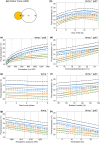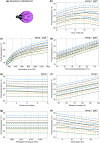Variations of floral temperature in changing weather conditions
- PMID: 38952664
- PMCID: PMC11214831
- DOI: 10.1002/ece3.11651
Variations of floral temperature in changing weather conditions
Abstract
Floral temperature is a flower characteristic that has the potential to impact the fitness of flowering plants and their pollinators. Likewise, the presence of floral temperature patterns, areas of contrasting temperature across the flower, can have similar impacts on the fitness of both mutualists. It is currently poorly understood how floral temperature changes under the influence of different weather conditions, and how floral traits may moderate these changes. The way that floral temperature changes with weather conditions will impact how stable floral temperatures are over time and their utility to plants and pollinators. The stability of floral temperature cues is likely to facilitate effective plant-pollinator interactions and play a role in the plant's reproductive success. We use thermal imaging to monitor how floral temperatures and temperature patterns of four plant species (Cistus 'snow fire' and 'snow white', Coreopsis verticillata and Geranium psilostemon) change with several weather variables (illumination, temperature; windspeed; cloud cover; humidity and pressure) during times that pollinators are active. All weather variables influenced floral temperature in one or more species. The directionality of these relationships was similar across species. In all species, light conditions (illumination) had the greatest influence on floral temperatures overall. Floral temperature and the extent to which flowers showed contrasting temperature patterns were influenced predominantly by light conditions. However, several weather variables had additional, lesser, influences. Furthermore, differences in floral traits, pigmentation and structure, likely resulted in differences in temperature responses to given conditions between species and different parts of the same flower. However, floral temperatures and contrasting temperature patterns that are sufficiently elevated for detection by pollinators were maintained across most conditions if flowers received moderate illumination. This suggests the presence of elevated floral temperature and contrasting temperature patterns are fairly constant and may have potential to influence plant-pollinator interactions across weather conditions.
Keywords: angiosperms; floral Signalling; floral display; floral temperature; infrared thermography; pollinators; weather effects.
© 2024 The Author(s). Ecology and Evolution published by John Wiley & Sons Ltd.
Conflict of interest statement
The authors declare no conflicts of interest.
Figures






References
-
- Altner, H. , & Loftus, R. (1985). Ultrastructure and function of insect thermo‐and hygroreceptors. Annual Review of Entomology, 30, 273–295. 10.1146/annurev.en.30.010185.001421 - DOI
-
- Ashman, T.‐L. , Knight, T. M. , Steets, J. A. , Amarasekare, P. , Burd, M. , Campbell, D. R. , Dudash, M. R. , Johnston, M. O. , Mazer, S. J. , Mitchell, R. J. , Morgan, M. T. , & Wilson, W. G. (2004). Pollen limitation of plant reproduction: Ecological and evolutionary causes and consequences. Ecology, 85, 2408–2421. 10.1890/03-8024 - DOI
-
- Bates, D. , Mächler, M. , Bolker, B. , & Walker, S. (2015). Fitting linear mixed‐effects models using lme4 . Journal of Statistical Software, 67, 1–48. 10.18637/jss.v067.i01 - DOI
LinkOut - more resources
Full Text Sources

